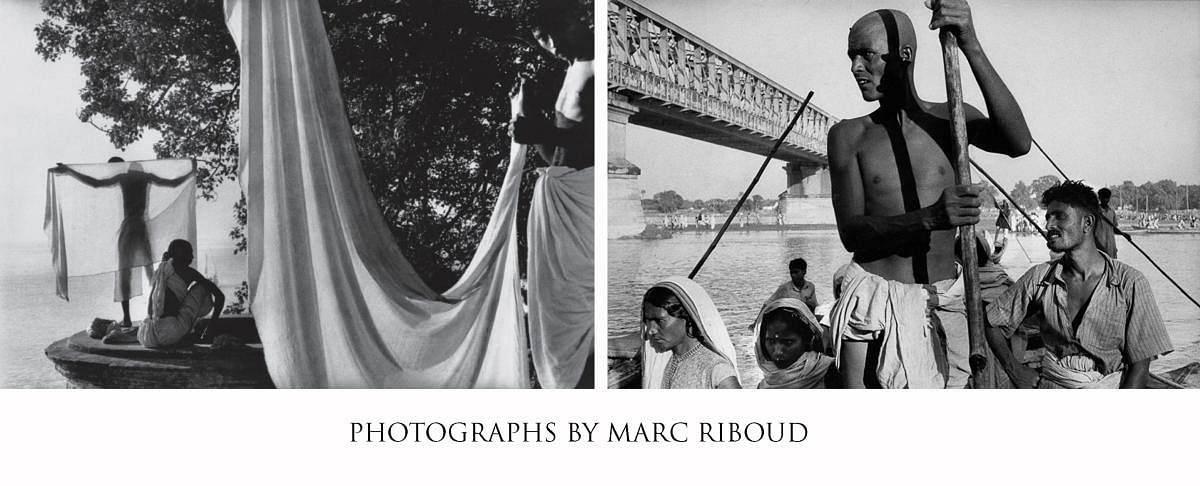
In the spring of 1955, Marc Riboud (1923 –2016) bought an old Land Rover and set out for a long ride from Paris to Calcutta (now Kolkata). Driving in the specially equipped vehicle, he crossed many unfamiliar terrains. Stopping first in Istanbul, he followed through the landscapes of Cappadocia and Anatolia. Entering Persia and Afghanistan, the four-wheel drive made extended forays into their tribal regions. The French photojournalist arrived in India in 1956; and spent a year covering the length and breadth of the country. He continued his trip by visiting Nepal; from there, he proceeded to China, ending his ‘Grand Tour’ in Japan before returning to France in 1958.
Riboud remained a globe-trotting photographer. Criss-crossing continents, he spent his life behind the camera capturing the lives of people across Asia, Africa and the Americas. His engrossing images included the return of Ayatollah Khomeini in Iran; armed conflicts in Algeria; the solidarity movement in Poland; end of apartheid in South Africa and the ravages of the Vietnam War. He was one of the first Western photographers to be allowed into China after the country’s Cultural Revolution in 1957. In November 1963, he accompanied French journalist Jean Daniel and travelled to Cuba to interview Fidel Castro in a Havana hotel room. In the late 1960s, he was in both South and North Vietnam, one of the rare photographers who was allowed entry.
He took the last pictures of Ho Chi Minh before the communist leader’s death in 1969. The Orient and Middle East held particular fascination for Riboud, who confessed catching the ‘Orient virus’ and loved nothing more than travelling through Asia.
Grace in all facets
Born in 1923 in Saint-Genis-Laval near Lyon, Riboud took his first pictures using a small vest pocket Kodak presented to him by his father for his 14th birthday. From 1945 to 1948, he studied engineering at the Ecole Centrale in Lyon. Three years thereafter, he made his decision to become a full-time photographer. Though never formally trained in the art, he shot prolifically over the next six decades and became known for his sensitive portrayal of people, places and events.
Shy by nature, Riboud spoke through his photographs. He captured life in all its facets lacing it with poetry, vigour and humour. He found grace and beauty in times of turbulence as well as tranquillity. “My vision of the world is simple,” he once revealed. “Tomorrow, each new day, I want to see the city, take new photographs, meet people and wander alone.” Two particular photographs of Riboud became iconic. Zazou, the Eiffel Tower’s painter, taken in Paris in 1953, regarded as one of the definitive Parisian images of its time, shows a workman painting the Tower while striking an amazingly dramatic and poetic pose. “That painter was joyful, singing as he worked,” recalled Riboud. “I think photographers should behave like him — he was free and carried little equipment.”
The Eiffel image, in many ways, summed up Riboud’s own approach to art; which essentially meant capturing ‘the rhymes and rhythms’ through the viewfinder of a hand-held camera. The photograph was published in Life magazine and became very popular. It also prompted an invite from famous photographers Henri Cartier-Bresson and Robert Capa to join the esteemed Magnum photo collective. (Riboud was an active member of Magnum from 1953 to 1979).
On 21 October 1967, Riboud took another photograph, which is remembered to this day. In the memorable picture, a young woman is seen holding up a flower in the face of aggression.
Peace March, Washington DC, was taken on a momentous day when thousands of people took part in a rally to protest against the war in Vietnam. The contrast between a chrysanthemum-holding 17-year-old Jan Rose Kasmir and the bayonet-wielding soldiers guarding the Pentagon, captured the collective mood of the time. “I had the feeling,” recalled Riboud, “the soldiers were more afraid of her than she was of the bayonets.”
There are many other Riboud images that are remembered fondly by discerning viewers. Among them is a striking composition of an antique dealer’s shop (Beijing/1965) depicting a typical street scene, visible through six windows. In another image, he captured the statue of Chinese leader Mao Zedong against billowing smoke in the industrial town of Wuhan, China, in 1971.
During his trip to India, Riboud (encouraged by Cartier-Bresson), met several leading cultural figures in India, including filmmaker Satyajit Ray, musician Ravi Shankar, writer Pupul Jaykar, and painter Paritosh Sen. He also extensively shot in Rajasthan, Varanasi, Lucknow, Kolkata, and Old Delhi, infusing both spontaneity and atmosphere into the frames. When Chinese premier Chou En-Lai met Jawaharlal Nehru, Riboud was there to capture the moment.
Becoming the eye
Riboud believed that a good photograph was always a surprise; and the camera has to be ready to catch it. He said that while photography could not change the world, “it can show the world, especially when it changes.” For him, photography was not about photographing a subject, but making a composition. “When, for example, I walk in a crowd, I don’t look for a face, I look for an image.”
He emphasised that developing a good eye was the most critical factor in photography. “You can go and buy the most expensive and high-tech camera you want and read the manual and know how to use the gadget. But, that doesn’t mean you are a photographer. What takes time is becoming the eye. We take good pictures, we become good photographers by living life, by talking to people, avoiding preconceived ideas and being open. That’s how we get to take pictures that matter.”
Riboud’s work was exhibited internationally. He also published over 30 books. Among the many awards he received were the Overseas Press Club award, the Time-Life Achievement, the Lucie Award and the ICP Infinity Award for Lifetime Achievement.
After a long struggle with Alzheimer’s disease, Riboud died on August 30, 2016 in Paris, aged 93.